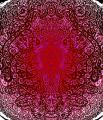
DMT-Nexus member
Posts: 1453 Joined: 05-Apr-2009 Last visit: 02-Feb-2014 Location: hypospace
|
I was perusing a local import store and found dried lotus leaves, from Thailand for $2 a lb and so I bought a package of them (1lb) The species is very likely to be Nelumbo nuciferaI am finding a lot of conflicting information about the alkaloids and effects of this particular plant. Alkaloids of Nelumbo nucifera
J. Kunitomo,
Y. Yoshikawa,
S. Tanaka,
Y. Imori,
K. Isoi
Faculty of Pharmaceutical Sciences, Mukogawa Women's University, Nishinomiya, Japan
Y. Masada,
K. Hashimoto,
T. Inoue
Kyoto College of Pharmacy, Kyoto, JapanQuote:The alkaloids of leaves of Nelumbo nucifera Gaertn. were examined using combined GLC-MS. The occurrence of four new alkaloids, dehydroroemerine (XII), dehydronuciferine (XI), dehydroanonaine (XIII) and N-methylisococlaurine (III) were revealed, besides the known roemerine (V), nuciferine (VI), anonaine (VII), pronuciferine (IV), N-nornuciferine (VIII), nornuciferine (IX), amepavine (I) and N-methylcoclaurine (II). I would like to make an extract of this plant, but all I have found thus far is alcohol based extracts and I was hoping to find more information about A/B or STB on this species. Tea of the leaves is also commonly used for medicinal effect. I will continue collating and presenting various information about this species in this thread as well, but it is my hope that someone who has performed an A/B or STB extraction on this species will join in and let me know how their experience went. The Active Ingredients of Jiang-Zhi-Ning:
Study of the Nelumbo nucifera Alkaloids and
Their Main Bioactive Metabolites
Jianxin Chen †, Xueling Ma †, Kuo Gao, Yong Wang, Huihui Zhao, Hao Wu, Juan Wang,
Hua Xie, Yulin OuYang, Liangtao Luo, Shuzhen Guo, Jing Han, Bing Liu and Wei Wang *
Beijing University of Chinese Medicine, 11 Bei San Huan Dong Lu, ChaoYang District,
Beijing 100029, ChinaQuote:Based on the structure of their nuclei, the Nelumbo nucifera alkaloids can be divided into three categories: single benzylisoquinolines, aporphines and dehydrogenated aporphines. The aporphine class includes nuciferine [6], N-nornuciferine [7], O-nornuciferine [7], liriodenine [8], roemerine [9], N-norarmepavine [10] and
2-hydroxy-1-methoxyaporphine [9]. More later, I want to continue this but have a lot to do right now.
|

DMT-Nexus member
Posts: 1824 Joined: 31-Jan-2011 Last visit: 05-Apr-2014 Location: paradise
|
You want the flowers, not the leaves. "Eat your vegetables and do as you're told, or you won't be going to the funfair!"
|

DMT-Nexus member
Posts: 1453 Joined: 05-Apr-2009 Last visit: 02-Feb-2014 Location: hypospace
|
christian wrote:You want the flowers, not the leaves. I want the leaves. they are called He Ye in traditional Chinese medicine I put some in the coffee maker. http://mt.china-papers.com/2/?p=45097
Quote:Lotus leaves, dry leaves of Nelumbo nucifera Gaertn., were cultured in both north and south of China. It was reported in traditional Chinese medicine that lotus leaves had the efficacies of losing weight, reducing fat and decreasing hypertension, etc. In modern research, scientists found that lotus leaves had the activities of stop bleeding, decreasing blood pressure, reducing weight and resisting arrhythmia and so on. The compositions in it include alkaloids, flavonoids, organics acid and tannins, etc. Alkaloids are known of the main bioactive ingredients in it...
Extraction: Extraction of the total alkaloids was performed by ion-exchange resin, the best conditions were decocting ground lotus leaves with 0.1% HCl solution at the ratio of 20:1 at 90℃. The leaves were extracted twice for duration of 2h each time. The content of total alkaloids was 2.12%. They did a microwave extraction in that one but called it: supersonic wave-extraction! 2% alkaloids isn't bad... leaves will do fine to experiment with for now
|

DMT-Nexus member
Posts: 152 Joined: 30-Dec-2012 Last visit: 17-Mar-2014
|
I got a pound of lotus (Nelumbo nucifera) leaves one time, it seemed so weak compared to the flowers. A very, very mild sedative at best, even using handfuls of leaves.
|

DMT-Nexus member
Posts: 1453 Joined: 05-Apr-2009 Last visit: 02-Feb-2014 Location: hypospace
|
I've yet to notice effects in terms of psychoactivity, but I have taken it in the evening and slept very well, having fallen asleep sooner and waking more well rested.
I was targeting vasodilation properties, seems to work ok.
|